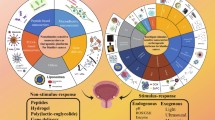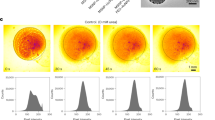Abstract
Purpose. Direct instillation of drug solutions into the bladder through a urethral catheter (i.e., intravesical therapy) evades systemic adverse effects of drugs used for bladder diseases. However, conventional vehicles for these drugs fail to extend duration of drug exposure in the bladder beyond the first voiding of urine postinstillation. The current study seeks to overcome the aforementioned inherent limitation of intravesical drug administration by using thermosensitive hydrogel as a matrix for sustained intravesical drug delivery.
Methods. Under halothane anesthesia, normal adult female Sprague-Dawley rats were catheterized with PE-50 tubing to instill either 0.02% w/v solution of fluorescein isothiocyanate (FITC) or the same amount of FITC in a 30% w/v dispersion of thermosensitive P[Poly(ethylene glycol)-Poly[lactic acid-co-glycolic acid]-Poly(ethylene glycol)P] (PEG-PLGA-PEG) polymer in a 0.1 M phosphate buffer. After instillations, rats were kept in metabolic cages for urine collection. Fluorescence emanating from FITC was measured in the urine at various time points up to 24 h after instillation. A rat model of cyclophosphamide-induced cystitis was chosen for the efficacy study using misoprostol as a model drug entrapped in the thermosensitive hydrogel in place of FITC. Efficacy of hydrogel containing misoprostol was compared against rat groups instilled with saline, hydrogel, and misoprostol independently.
Results. Prolonged drug exposure to the bladder afforded by hydrogel was evident from the time course of FITC elimination in the urine and by the green fluorescence of FITC seen at the bladder surface when isolated 24 h after instillation. Rats instilled with free FITC voided almost all of the fluorescence in the urine within the first 8 h, whereas rats instilled with hydrogel encapsulated FITC showed sustained release up to 24 h after instillation. Using a cyclophosphamide-induced cystitis model, rats instilled with misoprostol, a synthetic PGE1 analog, showed significantly reduced frequency of urine voiding (p \h 0.05) as compared to the rats instilled with saline. Histological examination of the urothelium showed near normal morphology in rats instilled with misoprostol in hydrogel, whereas extensive tissue damage was observed in rats instilled with saline.
Conclusion. Our study showed that PEG-PLGA-PEG polymer could be used as a viable sustained drug delivery system for intravesical therapy of diseases of the bladder such as cystitis using misoprostol.
Similar content being viewed by others
references
D. L. Lamm and J. G. Griffith. Intravesical therapy: Does it affect the natural history of bladder cancer? Semin. Urol. 10:39–44 (1992).
M. C. Walker, J. R. Masstera, C. N. Parris, P. J. Hepburn, and P. J. English. Intravesical chemotherapy in vitro studies on the relationship between dose and cytotoxicity. Urol. Res. 14:137–140 (1986).
K. Ueda, H. Sakagami, Y. Masui, and T. Okamura. Single instillation of hydroxypropylcellulose-doxorubicin as treatment for superficial bladder carcinoma. Cancer Chemother. Pharmacol. 35(Suppl):S81-S83 (1994).
B. Jeong, Y. H. Bae, D. S. Lee, and S. W. Kim. Biodegradable block copolymers as injectable drug-delivery systems. Nature 388:860–862 (1997).
B. Jeong, Y. H. Bae, and S. W. Kim. Biodegradable thermo-sensitive micelles of PEG-PLGA-PEG triblock polymer. Colloids and Surfaces B: Biointerfaces 16:185–193 (1999).
B. Jeong, Y. H. Bae, and S. W. Kim. In situ gelation of PEG-PLGA-PEG triblock copolymer aqueous solutions and degradation thereof. J. Biomed. Mater. Res. 50:171–177 (2000).
Y. J. Kim, S. Choi, J. J. Koh, M. Lee, K. S. Ko, and S. W. Kim. Controlled release of insulin from injectable biodegradable triblock copolymer. Pharm. Res. 18:548–550 (2001).
Z. Li, W. Ning, J. Wang, A. Choi, P. Y. Lee, P. Tyagi, and L. Huang. Controlled gene delivery system based on thermosensitive biodegradable hydrogel. Pharm. Res. 20:884–888 (2003).
E. M. Bulger and R. V. Maier. Lipid mediators in the pathophysiology of critical illness. Crit. Care Med. 28:N27-N36 (2000).
P. J. Cox. Cyclophosphamide cystitis—identification of acrolein as the causative agent. Biochem. Pharmacol. 28:2045–2049 (1979).
D. J. Grinberg-Funes, C. Sheldon, and M. Weiss. The use of prostaglandin F2 alpha for the prophylaxis of cyclophosphamide induced cystitis in rats. J. Urol. 144:1500–1504 (1990).
M. O. Fraser, Y. C. Chuang, P. Tyagi, T. Yokoyama, N. Yoshimura, L. Huang, W. C. De Groat, and M. B. Chancellor. Intravesical liposome administration—a novel treatment for hyperactive bladder in the rat. Urology 61:656–663 (2003).
Y. Igawa, T. Satoh, H. Mizusawa, S. Seki, H. Kato, O. Ishizuka, and O. Nishizawa. The role of capsaicin-sensitive afferents in autonomic dysreflexia in patients with spinal cord injury. BJU Int. 91:637–641 (2003).
S. Ritter and T. T. Dinh. Age-related changes in capsaicin-induced degeneration in rat brain. J. Comp. Neurol. 318:103–116 (1992).
D. N. Frangos, J. J. Killion, D. Fan, R. Fishbeck, A. C. von Eschenbach, and I. J. Fidler. The development of liposomes containing interferon alpha for the intravesical therapy of human superficial bladder cancer. J. Urol. 143:1252–1256 (1990).
B. Ronneberger, W. J. Kao, J. M. Anderson, and T. Kissel. In vivo biocompatibility study of ABA triblock copolymers consisting of poly (L-lactic-co-glycolic acid) A blocks attached to central poly(oxyethylene) B blocks. J. Biomed. Mater. Res. 30:31–40 (1996).
K. J. Zhu, Lin X, and Yang S. Preparation, characterization, and properties of polylactide (PLAO-poly(ethylene glycol)(PEG) copolymers: potential drug carriers. J. Appl. Polym. Sci 39:1–9 (1990).
B. Jeong, Y. H. Bae, and S. W. Kim. Drug release from biodegradable injectable thermosensitive hydrogel of PEG-PLGA-PEG triblock copolymers. J. Control. Rel. 63:155–163 (2000).
K. J. Gray, U. H. Engelmann, E. H. Johnson, and I. J. Fishman. Evaluation of misoprostol cytoprotection of the bladder with cyclophosphamide (Cytoxan) therapy. J. Urol. 136:497–500 (1986).
J. D. Kelly and M. R. Young, Johnston S. R, Keane P. F. Clinical response to an oral prostaglandin analogue in patients with interstitial cystitis. Eur. Urol. 34:53–56 (1998).
P. Y. Lee, Z. Li, and L. Huang. Thermosensitive hydrogel as a TGF-B gene delivery vehicle enhances diabetic wound healing. Pharm. Res. 20:1995–2000 (2003).
P. Tyagi, M. B. Chancellor, Z. Li, W. C. De Groat, N. Yoshimura, M. O. Fraser, and L. Huang. Urodynamic and immunohistochemical evaluation of intravesical capsaicin delivery using thermosensitive hydrogel and liposomes. J. Urol. 171:483–489 (2004).
Author information
Authors and Affiliations
Rights and permissions
About this article
Cite this article
Tyagi, P., Li, Z., Chancellor, M. et al. Sustained Intravesical Drug Delivery Using Thermosensitive Hydrogel. Pharm Res 21, 832–837 (2004). https://doi.org/10.1023/B:PHAM.0000026436.62869.9c
Issue Date:
DOI: https://doi.org/10.1023/B:PHAM.0000026436.62869.9c




